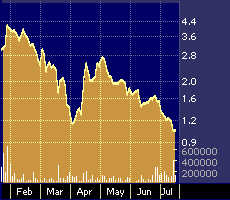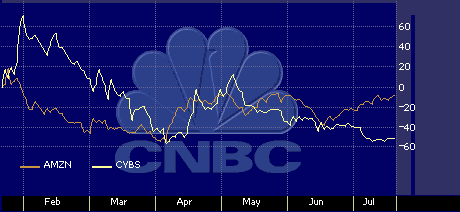
Transactions Put CyberSource in Driver’s Seat
Transactions Put CyberSource in Driver’s Seat
by Hal Plotkin
Silicon Valley Correspondent
Analysts say CyberSource Corporation’s smart marketing and winning business model are the main reasons why the company’s stock is up more than 250 percent since its June IPO.
“CyberSource has a compelling story for investors who like companies that provide e-commerce infrastructure,” says David Baltaxe, principal Internet commerce analyst at Current Analysis, a market research firm based in Sterling, Virginia. “They make money every time one of their customers sells something, and they’ve done a very good job of partnering up.”
San Jose-based CyberSource {CYBS}, which specializes in secure online transaction processing, was spun off from software retailer Beyond.com {BYND}, based in Sunnyvale, California, in 1994.

CYBS 6-month chart
BYND 6-month chart
“Beyond.com was one of the first to face the security issues involved with selling products online,” says Evan Ellis, CyberSource’s president and chief operating officer. “In the process, we developed a product many other companies need.”
CyberSource went public on June 23 at an initial offering price of $11 a share. More recently, shares have been changing hands around the $50 mark.
CyberSource currently boasts more than 700 customers, including major accounts such as BUY.com, Compaq Computer, Nike.com, and Casio.
The firm’s progress is, however, better reflected by the dramatic increases in the number of online transactions handled; 800,000 in 1997, 8.7 million in 1998, and more than 8 million in the second quarter of 1999 alone.
CyberSource also recently inked a deal with Amazon.com to bundle the company’s fraud detection product into the services Amazon sells merchants who participate in its zShop online shopping mall.

6-month comparison chart: AMZN vs. CYBS
Installing CyberSource software is quick and easy and costs merchants practically nothing. In return, CyberSource receives a commission between .07 cents and 49 cents on each transaction.
“I like the company’s business model,” says Carl Lehman, an analyst at the Meta Group, a market research firm based in Boston, Massachusetts. “You use it and you pay, you don’t use it and you don’t pay. That’s a beautiful thing.”
CyberSource’s pay-as-you go marketing approach is just one factor in the company’s success. From its beginnings, CyberSource emphasized fraud detection in order to differentiate itself from the dozens of other companies offering online transaction processing services. “They touched a raw nerve, apparently” says Baltaxe of Current Analysis.
CyberSource’s technology performs real-time verification of customer identities and shipping addresses. When a customer places an order online, CyberSource immediately notifies the merchant of the probability the order is legitimate based upon an assessment of 33 different data fields and more than 150 modeling calculations.
The factors assessed include the usual ones, such as the validity of credit card information, in addition to more subtle clues that an order may be bogus, such as the time of day where the purchase is being made, quantity of items ordered, and other factors.
“When someone takes an order on the phone they’re usually trained to detect fraud,” says CyberSource’s president Ellis. “We do the same thing with artificial intelligence, in real-time, every time a customer hits the “buy” button.” The technology also calculates appropriate sales taxes in addition to helping merchants comply with various export control laws.
Ellis says fewer than 1 percent of all CyberSource transactions turn out to be fraudulent, an important selling feature since online merchants often don’t have the same protections against fraudulent credit card use enjoyed by brick and mortar operations.
CyberSource’s focus on fraud detection, “helped them gain traction with large e-commerce sites,” says Albert Pang, research director at International Data Corporation based in San Jose, California.
The company is also credited with championing other innovations, for example, “channel protection services,” which automatically route online orders to existing sales channels so companies can sell over the Internet without destroying relationships with long-standing marketing partners.
“Alienating existing sales channels can crash a company,” says Lehman of the Meta Group.
CyberSource’s progress recently won the attention of Visa U.S.A., which has entered into a joint marketing agreement with the company. Under the terms of the agreement, Visa is promoting CyberSource’s fraud detection service with merchants who accept the Visa card. In return, merchants who accept Visa cards receive a 15 percent discount from CyberSource.
“As we move into the holiday season, it is important that we provide Internet merchants with the best tools to help them profitably manage their businesses,” said Visa U.S.A.’s senior vice president, Jim Degracia, when the deal was announced in late September. The agreement also includes a pledge the two companies will continue to collaborate on online fraud detection.
“I think it’s an important agreement,” says David Shatsky, an analyst at Jupiter Communications, based in New York. “It represents a pretty significant investment of money and intellectual capital. Visa is certainly a major player.”
Shatsky says he expects to see CyberSource thrive during the coming holiday shopping season due to the company’s transaction-oriented revenue model. “The largest e-commerce sites are now doing 15,000 transactions a day,” he says. “We expect that number to quadruple during the holidays.”
The only sour note sounded on CyberSource’s prospects involves the question of whether the company could eventually become a victim of its own success.
“Right now, companies are willing to outsource their transactions,” says Pang of IDC. “But when the sales volumes get higher, they may feel they are paying too much and decide to do it themselves.”
Carl Lehman, of the Meta Group, doesn’t think that’s likely to happen. “The services CyberSource provides are not what any self-respecting company would want to do themselves,” he says. Instead, Lehman says companies will increasingly outsource items such as online transaction processing and fraud detection so they can focus on building competitive advantages in their own markets. “Outsourcing,” he says, “is a well-established trend.”
CyberSource also stands to benefit from what Baltaxe of Current Analysis calls the “inertia factor.” He says merchants will probably be reluctant to replace CyberSource after they sign up due to the expense and disruptions involved.
“Once CyberSource gets its foot in the door, it’s hard to dislodge. After all, what are the costs of pulling out a transaction processing system and putting something new in its place? That bodes very well for the long-term position of the company.”
CyberSource posted a net loss of $6.9 million for the second quarter of 1999, ending June 30, on revenues of $2.5 million, as compared with a net loss of $2 million on sales of $699,000 for the same period last year.


